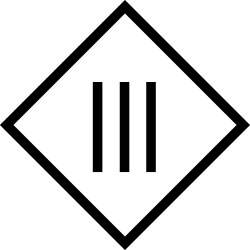Contractual designation of the characteristics of electrical and electrotechnical equipment from the point of view of protection against electric shock. There are four classes of protection: 0, I, II and III. Class 0 equipment only has protection against direct contact (basic protection), which is provided by the basic insulation. In the event of damage to the insulation, electric shock protection should be provided by placing the equipment out of reach and isolating the workplace.
In Poland, equipment of this class is approved for use in the absence of simultaneous human contact with the equipment and earth potential. In the case of class 0, no markings are applied.
Class I
Class I equipment has basic insulation which provides protection against direct contact. In addition, to ensure protection against indirect contact (interference protection or additional protection), a protective conductor (PE) or a protective-neutral conductor (PEN) is connected to the protective terminal of the appliance. This achieves: -protection by automatic de-energisation through the use of suitable devices -restriction of touch voltages to levels not exceeding the safe touch voltage (UL) values established for the environmental conditions concerned.
 Class II equipment is characterised by the use of reinforced insulation, which provides both direct and indirect contact protection. Another way to provide protection against electric shock in class II equipment is to use primary and secondary insulation. Because reinforced or additional insulation is used, it is not necessary to connect the equipment enclosure to the protective earth conductor, and it is possible to power this class of equipment, for example, via two-wire cables with IEC C7 connectors (the so-called 'figure-eight').
Class II equipment is characterised by the use of reinforced insulation, which provides both direct and indirect contact protection. Another way to provide protection against electric shock in class II equipment is to use primary and secondary insulation. Because reinforced or additional insulation is used, it is not necessary to connect the equipment enclosure to the protective earth conductor, and it is possible to power this class of equipment, for example, via two-wire cables with IEC C7 connectors (the so-called 'figure-eight').
Class III

In Class III equipment, protection against electric shock is provided by supplying an extra-low voltage (ELV) not exceeding the permissible safety touch voltage (UL) for the given environmental conditions.